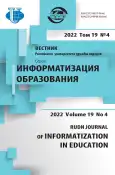Применение мобильных 3D-моделей для демонстрации недоступных лабораторных опытов и объектов при изучении химии и биологии в основной школе
- Авторы: Балькина Е.А.1
-
Учреждения:
- Центр технического творчества детей «НОВАпарк»
- Выпуск: Том 19, № 4 (2022)
- Страницы: 360-371
- Раздел: РАЗРАБОТКА УЧЕБНЫХ ПРОГРАММ И ЭЛЕКТРОННЫХ РЕСУРСОВ
- URL: https://journal-vniispk.ru/2312-8631/article/view/321299
- DOI: https://doi.org/10.22363/2312-8631-2022-19-4-360-371
- ID: 321299
Цитировать
Полный текст
Аннотация
Постановка проблемы. Технологическое развитие дополненной реальности становится более впечатляющим с каждым годом. Но, несмотря на все преимущества и возможности использования дополненной реальности в современном мире, в сфере образования она все еще находится в зачаточном состоянии. Одним из самых больших преимуществ использования технологии дополненной реальности в изучении естественных наук является ее способность визуализировать абстрактные концепции, воспроизводить дорогие, опасные или длительные опыты, а также демонстрировать редкие объекты. Эти способности дополненной реальности отлично подходят для преподавания химии и биологии в основной школе, так как могут визуализировать недоступные объекты, процессы и явления на уроках без использования больших временных, материальных и технических ресурсов. На данный момент не накоплен достаточный опыт применения этой технологии при изучении естественно-научных дисциплин, в частности химии и биологии. Таким образом, возникает необходимость в проведении соответствующего научного педагогического исследования для определения эффекта от внедрения технологии дополненной реальности в изучение естественно-научных дисциплин. Методология. Применялись методы проектирования модели обучения, педагогического эксперимента, наблюдения, беседы, обобщения полученного опыта. Результаты. Представлены результаты педагогического эксперимента по применению мобильных 3D-моделей для демонстрации недоступных лабораторных опытов и объектов при изучении химии и биологии в основной школе, нацеленного на анализ и выделение наиболее значимых для практики образцов применения этой технологии. Описаны сущность и особенности применения мобильных 3D-моделей в изучении химии и биологии. Выявлены значимые аспекты применения такой технологии в современной школе. Заключение. Опыт организации уроков с демонстрацией недоступных лабораторных опытов и объектов при изучении химии и биологии в основной школе позволяет сделать вывод о наличии существенных отличий образовательного процесса, реализуемого с применением мобильных 3D-моделей и технологии дополненной реальности.
Об авторах
Екатерина Александровна Балькина
Центр технического творчества детей «НОВАпарк»
Автор, ответственный за переписку.
Email: katerinabalkina@gmail.com
ORCID iD: 0000-0002-7033-9152
заведующий структурным подразделением
Российская Федерация, 446200, Новокуйбышевск, ул. Суворова, д. 20, корп. 1Список литературы
- Jing Y. VR, AR, and wearable technologies in education: an introduction. In: Zhang Y, Cristol D. (eds.) Handbook of Mobile Teaching and Learning. Singapore: Springer; 2019. https://doi.org/10.1007/978-981-13-2766-7_109
- Ignatieva EA. Use of augmented reality technology in the educational process. I. Yakovlev Chuvash State Pedagogical University Bulletin. 2019;(4):177–182. (In Russ.) https://doi.org/10.26293/chgpu.2019.104.4.024
- Yuen S., Yaoyuneyong G., Johnson E. Augmented reality: an overview and five directions for AR in education. Journal of Educational Technology Development and Exchange. 2011;4(1):119–140.
- Kalugin DYu, Osokina OM. Technologies of augmented reality in education. Technological Education and Sustainable Development of the Region. 2014;1(1–1):237–243. (In Russ.)
- Grinshkun VV, Krasnova GA. Development of education in the era of the fourth industrial revolution. Informatika i Obrazovanie. 2017;(1):42–45. (In Russ.)
- Onalbek ZK, Grinshkun VV, Omarov BS. The main systems and types of forming of future teacher-trainers' professional competence. Life Science Journal. 2013;10(4): 2397–2400.
- Sitnikova ES, Kuteneva TA. Virtual and augmented reality: correlation of concepts. Strategies for the Development of Social Communities, Institutions and Territories: Materials of the IV International Scientific and Practical Conference (Yekaterinburg, 23–24 April 2018) (vol. 1). Yekaterinburg: Ural University Publ.; 2018. p. 298–302. (In Russ.)
- Adamovich KA, Kapuza AV, Zakharov AB, Frumin ID. The main results of Russian students in the international study of reading, mathematical and natural science literacy PISA-2018 and their interpretation. Moscow: NRU HSE; 2019. (In Russ.)
- Kosaretsky SG, Barannikov KA, Belikov AA. Russian school: the beginning of the XXI century. Moscow: Higher School of Economics Publ.; 2019. (In Russ.)
- Vakhrusheva TS. Application of augmented reality technologies in education. Science of the Present and Future. 2017;1:37–39. (In Russ.)
- Cheong CWL, Guan X, Hu X. Augmented reality (AR) for biology learning: a quasi-experiment study with high school students. In: Wang Y, Joksimović S, San Pedro MOZ, Way JD, Whitmer J. (eds.) Social and Emotional Learning and Complex Skills Assessment. Advances in Analytics for Learning and Teaching. Cham: Springer; 2022. https://doi.org/10.1007/978-3-031-06333-6_9
- Kalken AM, Fedorov YuV, Spirina EA. Virtual and augmented reality in education: myth or reality? The Paradigm of Modern Science through the Eyes of the Young: Collection of Materials of the XIV International Scientific and Practical Conference Dedicated to the Memory of the Founders of the Branch T.Zh. Atzhanov and A.M. Rodnov, the 25th anniversary of the Constitution and the Assembly of the People of Kazakhstan. Kostanay; 2020. p. 208–212. (In Russ.)
- Belokhvostov AA, Arshansky EYa. Augmented reality in teaching chemistry: opportunities and prospects for use. Sviridovskie Readings. Minsk: BSU Publishing Center; 2018. p. 131–140. (In Russ.)
- Grigoriev SG, Rodionov MA, Kochetkova OA. Educational opportunities of augmented and virtual reality technologies. Informatics and Education. 2021;(10):43–56. (In Russ.) https://doi.org/10.32517/0234-0453-2021-36-10-43-56
- Arsentiev DA. Implementation of elements of augmented reality in educational and methodical literature. University book: Traditions, Modernity Materials of the Scientific-Practical Conference. Abrau-Durso: Southern Federal University Publishing House; 2015. p. 18–22. (In Russ.)
Дополнительные файлы









